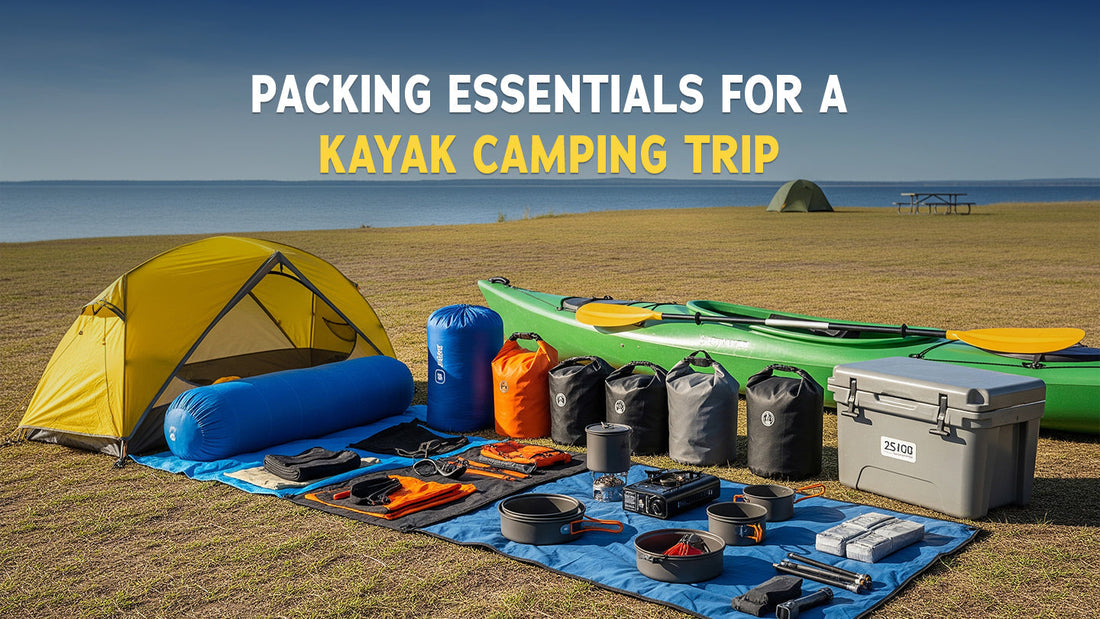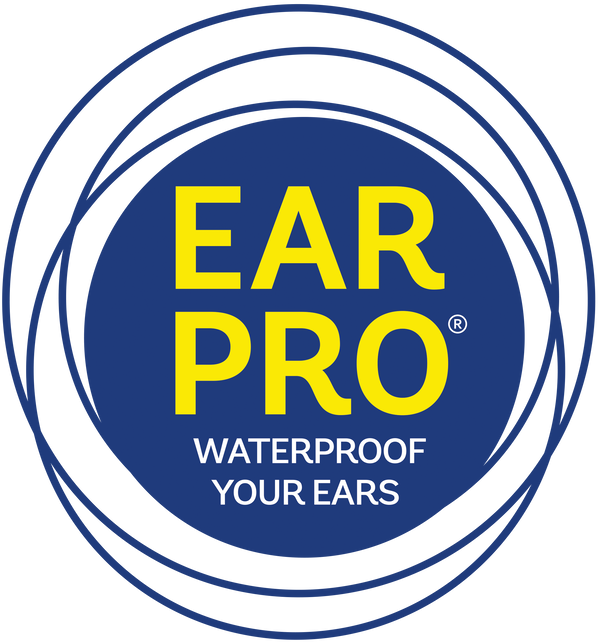
Packing Essentials for a Kayak Camping Trip
Share
Planning an overnight paddling trip can feel overwhelming. With so many gear lists online, it’s hard to know what to pack for kayak camping.
The essentials, however, are straightforward. Balance your boat, stay warm and dry, choose meals that are light yet filling, and keep your safety kit foolproof.
The guide below walks through every category, from smart dry‑bag organization to space‑saving camp‑kitchen ideas, so you can load your kayak with confidence, slip on your spray skirt, and paddle away without second‑guessing the gear tucked into your hatches.
Table of Contents
1. Must‑Have Gear for Kayak Camping Trips
2. How to Pack Your Kayak Efficiently and Safely
3. Essential Clothing for All‑Weather Conditions
4. Best Food and Meal‑Planning Tips for Paddlers
5. Camp Kitchen Gear That Saves Space
6. Sleep System Setup: Tents, Pads, and Bags
7. Personal Care and Hygiene on the Water
8. Dry Bag Organization Strategies
9. Safety Gear and Emergency Essentials
10. Conclusion
11. Frequently Asked Questions
Must‑Have Gear for Kayak Camping Trips
Before launching, start your checklist of what to pack for kayak camping with the gear that keeps you paddling, visible, and self‑reliant.
-
Boat & Basics – seaworthy kayak with intact hatch covers, deck lines, and fitted spray skirt; primary paddle plus a breakdown spare; bilge pump, sponge, and paddle float for self‑rescue
-
Navigation & Comms – deck compass, laminated chart in a map case, waterproof VHF or sat messenger/PLB; phone in a floating case as backup
-
On‑water Toolkit – multitool or knife, tow belt, repair tape/putty, lightweight hand pump, spare rudder cable
-
Hydration & Filtration – 2–3 L hydration bladder behind your seat, plus gravity filter or purification tabs for shore use
-
Day‑bag Essentials – lightweight gear for kayak trips, such as a head‑torch, sunscreen, insect repellent, sunglasses with a strap, a micro first‑aid kit, and a whistle clipped to your PFD
Need inspiration before you start packing? Check out our guide to the top 8 kayaking destinations in the U.S. for family‑friendly routes and stunning scenery.
How to Pack Your Kayak Efficiently and Safely
Before launching, start your checklist of what to pack for kayak camping with the gear that keeps you paddling, visible, and self‑reliant.
1. Trim first – heavier food and water low and centred to keep the boat’s centre of gravity stable; lighter items (sleep system, clothes) into the bow and stern
2. Module‑pack – group items by use (sleep, kitchen, clothing, emergency) in colour‑coded dry bags so nothing stays wet or goes missing at camp
3. Use every void – fill ends of the hull with soft items (tent poles down one side, rolled jacket down the other)
4. Double‑seal electronics in small Zip‑locks before they enter a dry bag; desiccant sachets stop condensation damage
5. Deck‑bag only for high‑need gear such as snacks, camera, maps, and paddle‑float; too much windage on deck can tire paddlers
Essential Clothing for All‑Weather Conditions
Dress for the water temperature, layering synthetics and weatherproof gear for kayak camping, so sudden changes never cut your trip short.
1. Dress for the water, not the air. A 15 °C lake can induce cold shock even on sunny days.
2. Layering system:
-
Synthetic base layer (no cotton)
-
Lightweight fleece or wool mid‑layer
-
Paddling jacket or dry‑top for splash and rain
-
Wet‑suit (3 mm) for cool water; full dry‑suit with insulating layers for <10 °C water
3. Camp wear: quick‑dry shorts/pants, insulating puffy, beanie, and camp shoes. Sun hoodies and bug‑proof pants are worth their weight in morale.
Best Food and Meal‑Planning Tips for Paddlers
Lightweight, high‑calorie meals and no‑cook lunches keep energy high while saving fuel and hatch space. Here’s a list of food ideas for kayak camping:
1. Dehydrate at home – fruits, refried beans, chilli, and salsa dry superbly and re‑hydrate fast; cut bulk and save fuel
2. Plan for calories ≈ 3,000–3,500 kcal/day; paddling burns more than hiking because you’re constantly bracing and balancing
3. Meal matrix:
-
Breakfast: instant oats + dried fruit & nut butter
-
Lunch: tortillas, hard cheese, summer sausage; no‑cook to keep moving
-
Dinner: dehydrated one‑pot meals, couscous, or ramen with foil‑pouch protein
4. Snacks within arm’s reach – trail mix, energy chews in a deck pocket for on‑water graze
Camp Kitchen Gear That Saves Space
Focus on compact stoves, collapsible pots, and multipurpose utensils when deciding what to pack for kayak camping in the galley. These are some camp kitchen plans for paddlers:
-
Collapsible 1.3 L pot set, nesting bowls & mugs; silicone lids double as plates
-
Pocket‑rocket canister stove + windscreen (white‑gas stoves only if temps < –5 °C)
-
Multi‑utensil (spork + spatula edge) for each camper, not a fistful of cutlery
-
AeroPress Go or travel French‑press for morning coffee—tiny footprint, big morale
-
Microfibre camp towel and biodegradable soap for quick clean‑ups
Sleep System Setup: Tents, Pads, and Bags
For a multi-day kayaking supplies checklist, choose tent, mat, and bag combinations that fit through small hatches yet deliver the warmth and comfort you need to recover overnight.
-
Tent: 2‑person, sub‑2 kg, double‑wall with vestibule for wet gear. Shorter pole segments (< 45 cm) fit kayak hatches better
-
Pads: 7–9 cm inflatable mat (e.g., Nemo Quasar 3D) balances comfort and packed size (≈ 9 × 20 cm)
-
Bags/Quilts: 10 °C down bag for summer, 0 °C for shoulder seasons. Store loose in the hatch, then stuff once ashore to protect the loft
-
Groundsheet or Tyvek footprint keeps sand and mud off your tent floor
Personal Care and Hygiene on the Water
A simple routine of ear spray, biodegradable soap, and leave‑no‑trace toileting keeps you healthy and the waters pristine.
-
Ear protection: A mineral‑oil ear‑spray like Ear Pro forms a hydrophobic barrier, preventing trapped water that can lead to otitis externa, which is far simpler than treating an infection mid‑trip
-
Fresh‑water rinse or baby‑wipe “sponge bath” each night removes salt & bacteria; a quick‑dry towel + light lotion prevents skin irritation
-
Toileting: wag‑bags or catholes 60 m from water; pack out TP. Carry hand‑sanitiser lanyarded to a deck line for quick use
-
Medication kit: antihistamines, anti‑diarrhoeals, ear‑drops, blister patches
Dry Bag Organization Strategies
Color‑code and size‑match dry bags to streamline what to pack for kayak camping and avoid rummaging at every landing. Follow these dry bag packing tips for efficiency.
-
Dedicated dry bags: sleep system, camp clothes, food, day‑use, ditty/emergency. Colour coding or clear windows speed retrieval
-
Bleed excess air before sealing to help bags slide through hatches
-
Label externally with painter’s tape so partners can fetch the right item
-
Keep a 5 L “grab” bag clipped under deck‑bungees with rain shell, snacks, phone, and a small first‑aid kit
Safety Gear and Emergency Essentials
Carry tested safety items, rescue, and first‑aid tools within immediate reach so small mishaps in your kayak trip never turn into emergencies.
|
Item |
Purpose |
Stowage |
|
PFD (always worn) with whistle, knife & signal mirror |
Immediate flotation & signalling |
On body |
|
VHF radio + PLB/satellite messenger |
Mayday, weather |
PFD pocket |
|
Flares or laser flare |
Night/day visual signal |
Day hatch |
|
Comprehensive first‑aid kit incl. vinegar for stings |
Treat injuries |
Dry bag, easy access |
|
Tow rope(s) – 15 m & 5 m |
Assist tired/disabled paddler |
Coiled on deck |
|
Repair tape, spare rudder cable, zip‑ties |
Field fixes |
Tool bag |
|
Fire‑starter kit (ferro‑rod, tinder tabs) |
Warmth, signal |
Emergency bag |
|
Creates a hydrophobic barrier that helps prevent trapped water and otitis externa |
PFD pocket or hygiene dry‑bag |
Pro Tip: Pack a pocket‑size “ditch kit” (dry socks, high‑calorie bar, space blanket, mini headlamp) in the front of the cockpit; if you must swim to shore, you’ll have warmth and calories while waiting for rescue.
Conclusion
A kayak camping trip rewards every gram you plan and every litre you protect from water.
With a kayak camping gear checklist that includes smart packing, weather‑proof clothing, calorie‑dense meals, and a dialled‑in safety kit, you’ll spend less time troubleshooting and more time exploring hidden coves.
Don't forget your Ear Pro; that small bottle provides immense peace of mind as you paddle on.
Frequently Asked Questions
1. What gear is essential for kayak camping?
A seaworthy kayak, PFD, primary and spare paddles, bilge pump and paddle float, navigation and communication tools, weatherproof layers, colour‑coded dry bags, lightweight tent, sleeping pad and bag, compact stove, water filtration, first‑aid kit, and a mineral‑oil ear spray such as Ear Pro to guard against otitis externa.
2. How do you pack a kayak for overnight trips?
Stow heavy items low and centred, fill bow and stern with softer gear, group equipment by purpose in dry bags, double‑bag electronics, keep quick‑access items on deck, and test trim before you launch.
3. What kind of food should I bring for kayak camping?
Pack calorie‑dense, low‑bulk staples like instant oats, tortillas, hard cheese, jerky or foil‑pouch protein, dehydrated one‑pot dinners, trail mix, and electrolyte drink powders, about 3,000 to 3,500 calories per day.
4. How do I keep my gear dry while kayaking?
Invest in reliable dry bags, purge excess air before sealing, line electronics with freezer bags, store bags inside hatches instead of on deck, and wipe hatch gaskets clean each morning.

